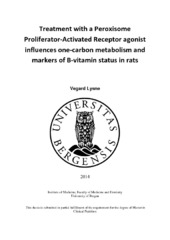Treatment with a Peroxisome Proliferator-Activated Receptor agonist influences one-carbon metabolism and markers of B-vitamin status in rats
Master thesis

Åpne
Permanent lenke
https://hdl.handle.net/1956/12329Utgivelsesdato
2014-06-15Metadata
Vis full innførselSamlinger
Sammendrag
Introduction: Elevated plasma concentration of homocysteine (Hcy) has been considered as a candidate risk factor of cardiovascular disease (CVD), but lowering Hcy with B-vitamins has not been demonstrated to improve prognosis among CVD patients. It has thus been suggested that elevated Hcy serves only as a marker of underlying pathology, which prompts investigation into possible related mechanisms. The choline oxidation pathway is directly linked to remethylation of Hcy to methionine, and increased systemic concentrations of metabolites along this pathway have previously been linked to major lifestyle diseases, including CVD. Choline-related remethylation of Hcy yields dimethylglycine (DMG). Notably, DMG has been demonstrated to be a strong predictor of CVD events and mortality, independent of other risk markers such as elevated Hcy levels. The peroxisome proliferator-activated receptor (PPAR) α is a nuclear receptor and key regulator of energy metabolism which is activated by both dietary fatty acids and synthetic ligands such as fibrates. This receptor has recently been demonstrated to influence the genetic transcription of key enzymes of the choline oxidation pathway, and increased PPARα activity was thus suggested to be a possible underlying mechanism for the association between DMG and CVD. Objective: The aim of the current study was to investigate the relationship between PPARα and one-carbon metabolism, with emphasis on the choline oxidation pathway. Most of the reactions in the metabolic pathways discussed depend on B-vitamins as cofactors, and hence we also assessed the associations between PPARα activation and systemic markers of B-vitamin status. A targeted metabolomic approach was implemented to investigate these relationships in a substudy of a long-term animal model. Methods: During 50 weeks, 30 male Wistar rats were randomized to receive ad libitum of either a low fat control diet, a high fat (HF) diet or a HF diet supplemented with tetradecylthioacetic acid (TTA), a pan-PPAR agonist with pronounced affinity towards PPARα. At the end of the study, the animals were sacrificed under non-fasting conditions. Blood was drawn by cardiac puncture and urine collected directly from the urinary bladder. Metabolite concentrations were determined by gas and liquid chromatography coupled to tandem mass spectrometry. The groups were compared by one-way ANOVA, and planned comparisons versus the control group were made for both intervention groups. Cohen’s d effect sizes were calculated and reported for all comparisons, and d > 0.8 was considered a large effect. As the results were not adjusted for multiple comparisons, p-values < 0.01 were considered statistically significant. Results: When comparing TTA-treated animals to the control group, TTA-treated animals had statistically significantly higher plasma DMG (d=5.05), glycine (d=1.3), serine (d=1.99), cystathionine (d=1.52), nicotinamide (d=6.4), methylnicotinamide (d=4.05), methylmalonic acid (d=3.98) and pyridoxal (d= 2.73), whereas plasma riboflavin (d=-1.6) and flavin mononucleotide (d=-2.22) were lower. Urinary concentrations of DMG (d=1.98), sarcosine (d=1.16) and methylmalonic acid (d=1.89) were higher among TTA treated rats. When comparing HF to the control group, no statistically significant differences were observed on either plasma or urinary concentrations of one-carbon metabolites or markers of B-vitamin status. However, the small sample size may have impeded statistical significance, as some of the differences were considered large. No differences were observed in urine according to dietary fat intake. Conclusion: Long-term TTA treatment was associated with altered blood and urinary concentrations of one-carbon metabolites and markers of B-vitamin status in male Wistar rats. Particular large differences were observed for plasma DMG, NAM, mNAM and MMA, which were all higher among TTA-treated rats. Based on current and previous results, these effects are probably mainly mediated through PPARα. Our findings add to the evidence that one-carbon metabolism may be regulated by PPARs, and these candidate biomarkers of PPARα activity may prove to supply useful information which could help identifying human subgroups who will have clinical benefit of certain nutritional advice.